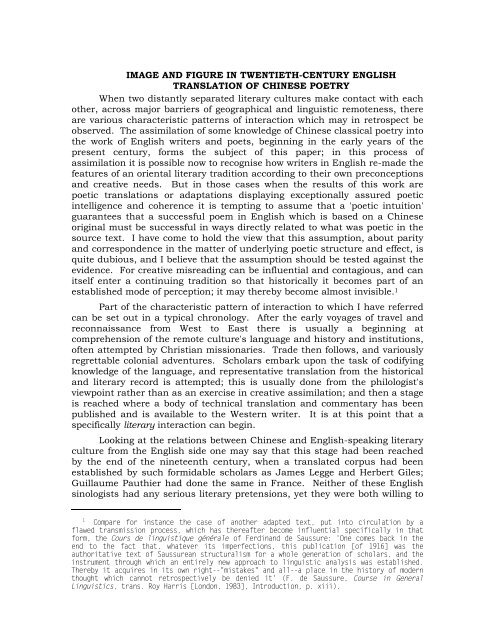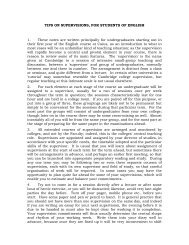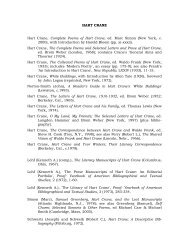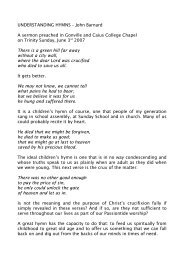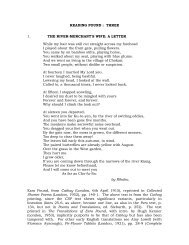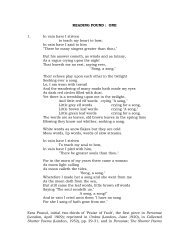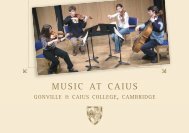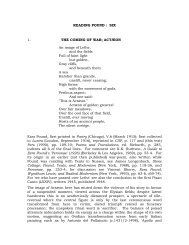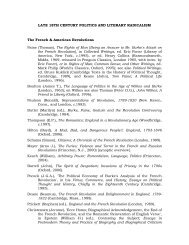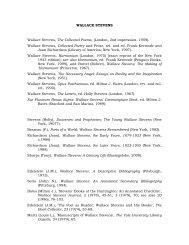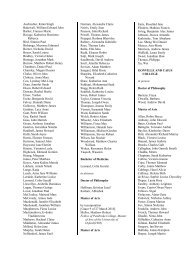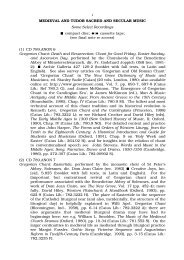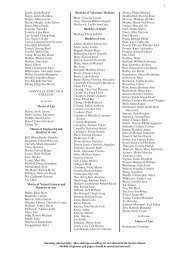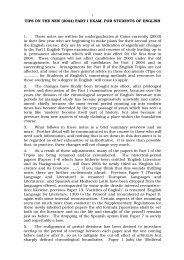IMAGE AND FIGURE IN TWENTIETH-CENTURY ENGLISH ...
IMAGE AND FIGURE IN TWENTIETH-CENTURY ENGLISH ...
IMAGE AND FIGURE IN TWENTIETH-CENTURY ENGLISH ...
- No tags were found...
Create successful ePaper yourself
Turn your PDF publications into a flip-book with our unique Google optimized e-Paper software.
<strong>IMAGE</strong> <strong>AND</strong> <strong>FIGURE</strong> <strong>IN</strong> <strong>TWENTIETH</strong>-<strong>CENTURY</strong> <strong>ENGLISH</strong><br />
TRANSLATION OF CH<strong>IN</strong>ESE POETRY<br />
When two distantly separated literary cultures make contact with each<br />
other, across major barriers of geographical and linguistic remoteness, there<br />
are various characteristic patterns of interaction which may in retrospect be<br />
observed. The assimilation of some knowledge of Chinese classical poetry into<br />
the work of English writers and poets, beginning in the early years of the<br />
present century, forms the subject of this paper; in this process of<br />
assimilation it is possible now to recognise how writers in English re-made the<br />
features of an oriental literary tradition according to their own preconceptions<br />
and creative needs. But in those cases when the results of this work are<br />
poetic translations or adaptations displaying exceptionally assured poetic<br />
intelligence and coherence it is tempting to assume that a 'poetic intuition'<br />
guarantees that a successful poem in English which is based on a Chinese<br />
original must be successful in ways directly related to what was poetic in the<br />
source text. I have come to hold the view that this assumption, about parity<br />
and correspondence in the matter of underlying poetic structure and effect, is<br />
quite dubious, and I believe that the assumption should be tested against the<br />
evidence. For creative misreading can be influential and contagious, and can<br />
itself enter a continuing tradition so that historically it becomes part of an<br />
established mode of perception; it may thereby become almost invisible. 1<br />
Part of the characteristic pattern of interaction to which I have referred<br />
can be set out in a typical chronology. After the early voyages of travel and<br />
reconnaissance from West to East there is usually a beginning at<br />
comprehension of the remote culture's language and history and institutions,<br />
often attempted by Christian missionaries. Trade then follows, and variously<br />
regrettable colonial adventures. Scholars embark upon the task of codifying<br />
knowledge of the language, and representative translation from the historical<br />
and literary record is attempted; this is usually done from the philologist's<br />
viewpoint rather than as an exercise in creative assimilation; and then a stage<br />
is reached where a body of technical translation and commentary has been<br />
published and is available to the Western writer. It is at this point that a<br />
specifically literary interaction can begin.<br />
Looking at the relations between Chinese and English-speaking literary<br />
culture from the English side one may say that this stage had been reached<br />
by the end of the nineteenth century, when a translated corpus had been<br />
established by such formidable scholars as James Legge and Herbert Giles;<br />
Guillaume Pauthier had done the same in France. Neither of these English<br />
sinologists had any serious literary pretensions, yet they were both willing to<br />
1<br />
Compare for instance the case of another adapted text, put into circulation by a<br />
flawed transmission process, which has thereafter become influential specifically in that<br />
form, the Cours de linguistique générale of Ferdinand de Saussure: 'One comes back in the<br />
end to the fact that, whatever its imperfections, this publication [of 1916] was the<br />
authoritative text of Saussurean structuralism for a whole generation of scholars, and the<br />
instrument through which an entirely new approach to linguistic analysis was established.<br />
Thereby it acquires in its own right--"mistakes" and all--a place in the history of modern<br />
thought which cannot retrospectively be denied it' (F. de Saussure, Course in General<br />
Linguistics, trans. Roy Harris [London, 1983], Introduction, p. xiii).
2<br />
address their translations to a non-professional readership. The forms of<br />
expression which both scholars adopted, when confronted with texts in verse,<br />
were thus ordinarily conventional; the distinctive foreignness of their originals<br />
largely vanished under the reassuringly familiar appearance of mainstream<br />
Victorian 'poetic' treatment. No assumption is advanced by such work, either<br />
explicitly or tacitly, that the English form of expression attempts any close<br />
stylistic correspondence with the originals, except in certain merely extrinsic<br />
formulae such as rhyme, parallelism and the like; for the rest, whatever is<br />
'poetic' in the Chinese poem is made over into a normative English 'poeticism'<br />
so as to allow the English reader to accept that the experience carried across<br />
is recognisably 'poetic' according to established English expectation.<br />
By the beginning of the twentieth century a new generation of writers<br />
and self-taught scholars started to approach this set of texts and problems<br />
with a more radical motive: that of bringing the response to Chinese classical<br />
poetry into the forefront of innovative literary consciousness, and of<br />
attempting to identify the thematic and expressive characteristics of Chinese<br />
poetic art so as to work out a more radical interaction of Chinese and English.<br />
It is here, chiefly in the writing and theoretical discussion of Ezra Pound and<br />
Arthur Waley, that assumptions about parity and correspondence begin to<br />
form and to become influential in shaping perception. Because Ezra Pound<br />
himself influenced Waley, and was by far the more original poetic intelligence,<br />
it is upon his early development and practice that this enquiry must<br />
concentrate.<br />
The general outlines of Pound's attack upon Edwardian literary London<br />
and its belated Victorianism are well known, as are his discovery of Chinese<br />
and Japanese poetry and his work on the Fenollosa papers. But his<br />
transition through stages of development was extraordinarily rapid, and<br />
involved several overlaps and reversions, so that some careful detail is<br />
required. To summarise rather briskly, at the start, it may be said that by<br />
about 1909 Pound had made two kinds of attempt to propel himself free of<br />
listless Victorian lyricism. On the one hand he had tried for intensity of mood<br />
and feeling, following on from William Morris and Rossetti to the early writing<br />
of W.B. Yeats. On the other hand he had wanted to dramatise the psychology<br />
of feeling and to sharpen its idiom; here the chief exemplar was Browning.<br />
These two lines of advance did not connect with each other very well, and<br />
Pound tended to switch between them. In his 1909 collection Exultations, for<br />
example, the long poem 'Laudantes Decem Pulchritudinis Johannae Templi' is<br />
divided into sections assigned to different speaking voices; yet the principal<br />
mode is a vehement impressionism held back and qualified by an intermittent<br />
delicacy of hesitation:<br />
O pearls that hang on your little silver chains,<br />
The innumerable voices that are whispering<br />
Among you as you are drawn aside by the wind,<br />
Have brought to my mind the soft and eager speech<br />
Of one who hath great loveliness,<br />
Which is subtle as the beauty of the rains<br />
That hang low in the moonshine and bring<br />
The May softly among us, and unbind
3<br />
The streams and the crimson and white flowers and reach<br />
Deep down into the secret places.<br />
The impressionism here renders pathos of mood and its colouration; but the<br />
hesitation in rhythm and movement of phrase tends to isolate visual detail,<br />
like the 'pearls that hang on your little silver chains'. These are in context<br />
clearly raindrops, and thus an explicitly constructed figure is offered: yet the<br />
lightness and autonomy of presentation makes the lustre of pearls, the sheen<br />
of silver, the colour-patches of crimson and white from the rose-petals, float<br />
together so as to be disconnected from their descriptive frame. Almost, we<br />
might say, these are not figures which are acknowledged as products of<br />
rhetorical deliberateness, but rather images which disclaim a rhetorical<br />
motive and arrive upon the page by a more immediate interaction of<br />
heightened poetic attention and rhythmical concentration.<br />
In his 1910 essay on Dante included as a chapter in The Spirit of<br />
Romance Pound quoted Aristotle on the essential swiftness of perception<br />
underlying metaphor: '"The apt use of metaphor, arising, as it does, from a<br />
swift perception of relations, is the hall-mark of genius": thus says Aristotle. I<br />
use the term "comparison" to include metaphor, simile (which is a more<br />
leisurely expression of a kindred variety of thought), and the "language<br />
beyond metaphor", that is, the more compressed or elliptical expression of<br />
metaphorical perception. . . . It is in the swift forms of comparison . . . that<br />
Dante sets much of his beauty' (Spirit of Romance, p. 158). Pound does not<br />
yet have a term for this vivid compression, but the 'crimson and white flowers'<br />
which in his poem are unbound like the running stream come to float by<br />
virtue of this sudden release into the form of what in the Dante essay he<br />
called 'primary apparition'.<br />
This, then, is one of the thresholds of what Pound was a little later to<br />
announce as 'Imagism'. By some time in 1912, according to his own account,<br />
he had composed the two-line image poem, 'In a Station of the Metro', with its<br />
tacit orientalism superimposed upon metropolitan displacement; and in a now<br />
celebrated essay published in Poetry (Chicago) for March 1913, 'A Few Don'ts<br />
by an Imagiste', he was ready with a definition: 'An "Image" is that which<br />
presents an intellectual and emotional complex in an instant of time. . . . It is<br />
the presentation of such a "complex" instantaneously which gives that sense<br />
of sudden liberation; that sense of freedom from time limits and space limits;<br />
that sense of sudden growth, which we experience in the presence of the<br />
greatest works of art' (Literary Essays, p. 4). This theory of instantaneous<br />
presentation not only excludes, we should note, the development or extension<br />
of the image within the sequence of the poem; it also excludes any visible<br />
deliberateness by the poet in rhetorically positioning a figure in relation to an<br />
explicit or implicit context. The 'image' is to meet the reader's attention<br />
directly, as if there were scarcely any anterior poet in evidence at all, and as if<br />
the prevailing framework for interpretation and association could be jolted or<br />
floated into an entirely novel focus.<br />
In the search for precedent instances of such techniques of presentation<br />
we know that Pound, by training a linguist and by habit an eclectic, was<br />
roaming far and wide. Very soon he was to meet the widow of the American<br />
oriental art historian and student of Chinese poetry, Ernest Fenollosa, and to
4<br />
be entrusted with Fenollosa's drafts for the translation into English of Chinese<br />
classical poems; but this important encounter did not take place until late<br />
1913. And before this Pound had already become interested in Chinese<br />
poetry on his own account; not in the high T'ang poetry of Li Po but in the<br />
earlier compositions translated into stiffly literary English by Herbert Giles.<br />
This first phase of Pound's interest in Chinese poetry produced three<br />
'translations', freely adapted from the Giles versions, all first published<br />
together in February 1914 and probably composed some time in the previous<br />
year: 'After Ch'u Yuan'; 'Fan-Piece for her Imperial Lord'; and 'Liu Ch'e'.<br />
In his valuable and informative introductory essay on 'The Translation<br />
of Chinese Poetry', prefixed to his anthology of Poems of the Late T'ang,<br />
Professor Angus Graham says of Pound and his circle: 'Interest shifted from<br />
Japan to China after 1913, when Pound received the manuscripts of Ernest<br />
Fenollosa' (Late T'ang, p. 16); but this is to telescope the chronology somewhat<br />
misleadingly. We need to examine these earliest Chinese versions as part of<br />
the beginning of imagism, not as influenced by the theory and practice which<br />
Pound subsequently discovered had been advanced by Fenollosa. To start<br />
with a specific example we may consider 'Lin Ch'e'. Here first is the Giles<br />
account of the poem, by Emperor Wu of the Han (156-87 B.C.):<br />
The sound of rustling silk is stilled,<br />
With dust the marble courtyard filled;<br />
No footfalls echo on the floor,<br />
Fallen leaves in heaps block up the door. . . .<br />
For she, my pride, my lovely one, is lost,<br />
And I am left, in hopeless anguish tossed.<br />
Giles, Chinese Literature (1901)<br />
This is rather clumsily done, and we should notice that the effort to rhyme is<br />
conspicuously self-conscious; it is 'literary' by effort of adaptation and there is<br />
no attempt to suggest that the rhymes occur naturally or for intrinsic reasons.<br />
Now see what Pound has decided to do with this material:<br />
LIU CH'E<br />
The rustling of the silk is discontinued,<br />
Dust drifts over the court-yard,<br />
There is no sound of foot-fall, and the leaves<br />
Scurry into heaps and lie still,<br />
And she the rejoicer of the heart is beneath them:<br />
A wet leaf that clings to the threshold.<br />
Pound, Lustra (1916)<br />
Pound has at a stroke abandoned all rhyme and largely dismantled the<br />
couplet-rhythm. He has assumed that 'lost' in Giles was a euphemism for<br />
'dead' and so he has imagined the lady's grave beneath the fallen leaves which<br />
blow about the court-yard. Then he forces a strophic break into the poem, to<br />
sharpen its leaning-forward into a culminating gesture; and then we have<br />
what is a pure invention: a separate, almost wholly autonomous image,<br />
'presenting an intellectual and emotional complex in an instant of time'. If we<br />
glance at the slightly later translation of the same original by Arthur Waley we
5<br />
shall see that both Giles and he agree on making the last line an overt<br />
expression of personalised emotion. But for Pound that is altogether too like<br />
Yeats or William Morris or Dante Gabriel Rossetti; a 'direct treatment of the<br />
thing' must replace the statement of feeling, so that feeling is implied<br />
instantly. The word 'cling' suggests emotional dependency and hopeless<br />
attachment, but it is displaced from direct human application, just as it is<br />
isolated in prosody from the epitaph which precedes it. What Pound divined<br />
as the inner method of Chinese lyrical composition is recruited to justify and<br />
demonstrate his new practice of imagism.<br />
An even more radical act of selective compression is displayed in his<br />
reworking of the very early poem traditionally ascribed to Lady Pan, which<br />
had also been translated by Giles. As Pound encountered it, there were ten<br />
lines of extendedly plaintive outcry, rendered in the leisurely forms of explicit<br />
simile and dipping into an eighteenth century poetic diction for phrases like<br />
'the grateful gale' and 'torrid rage':<br />
O fair white silk, fresh from the weaver's loom,<br />
Clear as the frost, bright as the winter snow --<br />
See! friendship fashions out of thee a fan,<br />
Round as the round moon shines in heaven above,<br />
At home, abroad, a close companion thou,<br />
Stirring at every move the grateful gale.<br />
And yet I fear, ah me! that autumn chills,<br />
Cooling the dying summer's torrid rage,<br />
Will see thee laid neglected on the shelf,<br />
All thought of bygone days, like them bygone.<br />
Giles, Chinese Literature (1901)<br />
The object itself, we may say, the silken fan made and given as a mark of<br />
anxious favour, almost disappears in the Giles treatment under a great surge<br />
of descriptive attributes. By ruthless excision Pound fixes a direct attention<br />
upon the thing, sharpens the chill outline by laying the frost upon a precise<br />
grass-blade, and then compresses all the explicit emotion of the shift of<br />
season and mood into the irony of one word, 'also':<br />
FAN-PIECE, FOR HER IMPERIAL LORD<br />
O fan of white silk,<br />
clear as frost on the grass-blade,<br />
You also are laid aside.<br />
Pound, Lustra (1916)<br />
The title here is the most explicit expression in the whole performance,<br />
just as had been the case with 'In a Station of the Metro'; within the brief<br />
movement of Pound's version the comparison of the cooling white silk to frost<br />
is swiftly overtaken by the season of frost itself; in which neither the fan nor<br />
she who made it is any longer required. We may note that the Giles version<br />
contains six separate verb-formations, and that Watson and Birrell employ<br />
eight and nine respectively. Each of these three translations also points up<br />
the narrative contrast, between the summer season when the fan is needed<br />
and the coming autumn when it will be discarded; the explicit future tense
6<br />
appears ominously in all three versions. By contrast Pound, although<br />
working from the Giles version as his raw material, has reduced the poem to a<br />
single verb only, in the present tense, seizing upon the passive construction to<br />
shew how the opening descriptive phrases are finally subjugated to the<br />
peremptory whim of an implied but unnamed owner. Pound's highly<br />
compressed image has swiftness and sharpness and vivid, presentational<br />
brevity, all features which imagism was to claim as characteristics of Chinese<br />
poetic art; and yet none of the three versions of the Chinese poem made by<br />
those with direct knowledge of its language shew any of these features.<br />
The methods which these adaptations from Giles shew in process of<br />
being worked out were quickly incorporated into a canon of examples for the<br />
reform and rejuvenation of English poetry; writing in an essay hopefully titled<br />
'The Renaissance' and published in February 1915 Pound asserted:<br />
'Undoubtedly pure color is to be found in Chinese poetry, when we begin to<br />
know enough about it; indeed, a shadow of this perfection is already at hand<br />
in translations. Liu Ch'e, Chu Yuan, Chia I, and the great vers libre writers<br />
before the Petrarchan age of Li Po, are a treasury to which the next century<br />
may look for as great a stimulus as the renaissance had from the Greeks'<br />
(Literary Essays, p. 218; there wrongly dated as 1914).<br />
Waley, we may comment, knew perfectly well that the Chinese poems<br />
referred to were infinitely far from being vers libre of any sort; his 'Notes on<br />
Chinese Prosody' published in the Journal of the Royal Asiatic Society of April<br />
1918 makes that completely clear; yet he also chooses a kind of vers libre for<br />
his own translation. Professor Graham says of Pound's version of 'Liu Ch'e',<br />
in his essay already mentioned: 'Pound emerges triumphantly by discarding<br />
Giles and writing a new conclusion of his own. . . . It is Far Eastern in<br />
manner and feeling, but it transforms the poem and fully entitles him to claim<br />
it for his own' (Late T'ang, p. 36). Now I hesitate to offer disagreement with so<br />
accomplished a scholar, but I can only surmise that here Professor Graham<br />
has allowed himself to believe that, because Pound has produced a highly<br />
successful poem, he has somehow also captured something essential in the<br />
spirit of the original. That is an assumption of the kind I mentioned at the<br />
outset of this paper, and I believe it to be mistaken.<br />
But meanwhile, after these early imagist experiments with adaptations<br />
from the Chinese, Pound had by late 1913 met Mary Fenollosa in London and<br />
had been offered all of her late husband's working papers. This episode and<br />
its consequences have already been fully described, notably by Hugh Kenner<br />
in a rather insidiously Poundian manner, and somewhat more objectively by<br />
Earl Miner in his The Japanese Tradition in British and American Literature.<br />
Fenollosa had left drafts for an extended essay on The Chinese Written<br />
Character as a Medium for Poetry and after editorial reworking Pound saw this<br />
into print, initially in The Little Review, volume VI for 1919, spread over four<br />
successive numbers. Pound discovered in this essay much that confirmed<br />
and justified his convictions about the image and about 'direct treatment of<br />
the thing'; Fenollosa had stated that 'Poetic thought works by suggestion,<br />
crowding maximum meaning into the single phrase pregnant, charged, and<br />
luminous from within' (Chinese Written Character, p. 28), and such contention<br />
must have seemed an explicit endorsement of what Pound had done to 'Liu<br />
Ch'e'. The poetic theory of the twentieth-century Western imagist and of the
7<br />
early court poet of classical China seemed to coalesce. For Pound the concept<br />
of a pictographic idiom whose sequences visibly performed and compressed<br />
the operations of nature was thus launched upon its literary career; the act of<br />
metaphor was to precede an ascribed or intended meaning, and absolute<br />
metaphor was to float with a kind of charged non-attachment within a frame<br />
held sharp by rhythm and exactness of attention. Absolute metaphor was<br />
thus energetic and succinct, autonomous within the immediate context of its<br />
presentation, and connected to it not by links of reference or idiom but by<br />
feeling and inner rhythm; as Pound wrote in 1916, in his Gaudier = Brzeska:<br />
A Memoir, 'Imagisme is not symbolism. The symbolists deal in "association,"<br />
that is, in a sort of allusion, almost of allegory. They degraded the symbol to<br />
the status of a word. They made it a form of metonomy [sic]' (Gaudier =<br />
Brzeska, p. 97). We may say at this point that Chinese poetic practice, and<br />
the Chinese language itself, became for Pound at a critically formative stage in<br />
his career a demonstration against metonymy.<br />
At this point I must pause to introduce some more specific definition of<br />
terms, and from those to whom they may already be familiar I ask indulgence.<br />
I have already implied a difference between image and figure, and I now bring<br />
forward another parallel, contrasting relation between metaphor and<br />
metonymy. My rather condensed contention is that the Western rhetorical<br />
tradition of literary composition diagnosed the figurative construction of<br />
discourse so as to identify specific codes of expression and interpretation; the<br />
writer who came to employ such figures knew he was doing so, and the reader<br />
knew that the connected implications of such knowledge had formed part of<br />
the text to be understood. The deliberateness of figuration was a<br />
phenomenon of connection, because separate figures and their place in a<br />
sequence of variation and development each tacitly implied their part in the<br />
repertory of effects and constructions which comprised the whole literary<br />
discourse and its relations to the personal and social reality of which it offered<br />
a representation. Pound's theory of the poetic image, taking up earlier<br />
tendencies in Pater and Yeats and the English reception of the French<br />
symboliste poets, attempted to divest the presentational image of a context in<br />
the deliberateness of a connected structure of expression, and also to isolate it<br />
from any visible ties of reference or relation; the image was to be 'luminous<br />
from within'. Pound in fact admitted that a principle of construction was<br />
involved; in his monograph on the sculptor Gaudier = Brzeska, already<br />
referred to, he acknowledged that 'the "one image poem" is a form of superposition,<br />
that is to say, it is one idea set on top of another" (Gaudier =<br />
Brzeska, p. 89). But he in the same passage also seeks to pre-empt analysis<br />
of relations: 'In a poem of this sort one is trying to record the precise instant<br />
when a thing outward and objective transforms itself, or darts into a thing<br />
inward and subjective' (ibid.).<br />
In this way for Pound the image was to escape the authorial deliberation<br />
and the connections of implied reference which had variously characterised<br />
the Western tradition of rhetorical figures. In arguing for what he called<br />
'absolute metaphor' he also protested against any tendency to metonymy.<br />
This latter word is the name of a classical rhetorical figure, closely related to<br />
metaphor but distinct from it by virtue of the implied construction of its<br />
context. Metonymy and its sister-figure synecdoche both operate as figures of
8<br />
substitution, in which the act of choice of an attribute or representative part<br />
to stand in place of the context from which the choice was made is part of the<br />
activity of meaning in the text. I shall give some specific examples later, from<br />
which it will be seen that an habitual use of metonymy brings with it a<br />
connected repertory of allusion; indeed, the systematic allusional framework<br />
of poetic figuration is a central characteristic of metonymy as it has in recent<br />
Western theory (principally that of Roman Jakobson) come to be regarded as a<br />
mode of composition strongly contrasted with metaphor; since a metonymic<br />
system depends upon a pattern of figural components which are already<br />
associated together in a poetic discourse or context of connected formalisms<br />
from which combinations are produced, each local part of such a system preimplying<br />
the larger whole. In this mode metonymy comes to include<br />
synecdoche, because the mentioned part which implicates the deleted whole<br />
becomes by convention the sign or name for that whole; by the same token it<br />
also includes the figure of euphemism and the euphemistic pun. The<br />
convention governing deployment and these figures is one which must<br />
regulate both authorial practice and also the reader's acts of interpretation;<br />
hence, the code of allusion requires to be generally understood even though<br />
only a part of it may be activated by any one individual poem.<br />
By contrast with the foregoing a metaphoric practice does not implicate<br />
an established figural system, but selects extrinsic or separated elements on<br />
the basis of a newly-perceived relation which substitutes one more or less<br />
autonomous element for another; it constitutes a new and original relation,<br />
rather than invoking a familiar one. The separate-floating or 'luminous' image<br />
lies at the far end of this figurative spectrum, deliberately remote from the<br />
practice of metonymy; Pound's energetic movement, during his initial<br />
Imagistic phase, towards absolute metaphor and the darting juxtapositions of<br />
autonomous intensities of presentation, carried with it a more or less<br />
conscious wish to break up the associative contexts implied by metonymy.<br />
And his response to Fenollosa's draft essay on The Chinese Written Character<br />
was to see it as a primer of elemental metaphor. 2<br />
It may be seen by now, I hope, that figure generally and metonymy in<br />
particular share the feature of connection within an historical system of<br />
meanings; and that both image and metaphor entail claims, to greater or<br />
lesser extent, of independence from a prevalidated system. Fenollosa's essay<br />
shews clearly enough that he regarded Chinese poetic art as essentially<br />
metaphoric rather than allusional or metonymic, and indeed he regarded the<br />
written ideogram as itself charged with primal metaphor. Pound, already<br />
drawn to this view of the image, was on this authority ready to believe that the<br />
characteristic genius of Chinese poetry was specifically of this kind; and<br />
Pound's later development in his Cantos of this ideogramic theory of the image<br />
has exerted a widespread influence on twentieth century Western poetic<br />
theory and practice. But, we may pause to enquire, was this analysis of<br />
Chinese poetic art a correct one Do Chinese poems really work like this<br />
2<br />
For discussion of the metonymy/metaphor distinction, see David Lodge, The Modes of<br />
Modern Writing (1977); Gérard Genette, 'Métonymie chez Proust', Figures III (Paris, 1972);<br />
Alexander Gelley, 'Metonymy, Schematism, and the Space of Literature', New Literary History,<br />
11 (1980), 469-87; and Max Nänny, 'Context, Contiguity and Contact in Ezra Pound's<br />
Personae', ELH, 47 (1980), 386-98.
9<br />
The place for an initial consideration could well be the volume of<br />
translations from the Chinese which Pound adapted from the Fenollosa drafts<br />
and published in 1915 under the title Cathay. What is initially puzzling about<br />
much of this book, however, is that the poems are not in fact imagistic in<br />
construction at all; although many scholar-critics and literary historians have<br />
been so bemused by their own expectations that they have believed otherwise.<br />
Indeed, in his celebrated version of Li Po's 'The Jewel Stairs' Grievance' Pound<br />
presented a text which looked superficially like a sequence of luminously<br />
floating images; but he supplied an interpretative note to it in which he<br />
pointedly explicated the allusional metonymies upon which he took the<br />
poem's meaning to be based. But let us examine in closer detail his version of<br />
another celebrated poem, on which he supplied no note, and then we may<br />
compare his translation with those produced by other scholars writing in<br />
English. Here first is Pound's Cathay translation titled 'The Beautiful Toilet':<br />
Blue, blue is the grass about the river<br />
And the willows have overfilled the close garden.<br />
And within, the mistress, in the midmost of her youth,<br />
White, white of face, hesitates, passing the door.<br />
Slender, she puts forth a slender hand,<br />
And she was a courtezan in the old days,<br />
And she has married a sot,<br />
Who now goes drunkenly out<br />
And leaves her too much alone.<br />
Pound, Cathay (1915), p. 7.<br />
This is, of course, the second of the Nineteen Old Poems, which had<br />
previously been translated by Giles and which was also a little later translated<br />
by Waley. Giles again keeps up a monotonously pert rhyming, adopting<br />
whatever common features of Victorian poetic vocabulary will come easily to<br />
hand to install a pastiche of Tennyson and Fitzgerald's Rubaiyat of Omar<br />
Khayyam. It should be remembered, here, that Giles believed his chief<br />
difficulty was to convince English readers that Chinese poems could be<br />
recognised as 'poetic' by any standards known to them, so that to make such<br />
a translation look instantly familiar to his intended readership was a<br />
condition of reasonable success.<br />
Pound's version, by contrast, is more wavering and hesitant in rhythm.<br />
The presence of the willows is allowed to be suggestive of delicate but overluxuriant<br />
enclosure, the qualities of nature metaphorically transferred to the<br />
isolation of the mistress by a brilliant internal chiasmus or crossing-over of<br />
sound values (willows, overfilled) and an implicit comparison of trailing<br />
branches with the tresses of the mistress, calling up by further implication<br />
the dampening mist of the low water-meadows and the subdued undertone of<br />
distress in the traditional Western associations of the weeping willow. The<br />
abruptness of rhythm in the second strophe is in pointed contrast to the<br />
hesitancy of the first, overriding the prosody of a repeated stanza-form to<br />
make a pronounced contrast of mood. Waley's version of the same poem is<br />
more mechanical in rhythm and he breaks up his lines so as to destroy any<br />
sense of stanzaic movement. Pound's version would, by a modern reader of
10<br />
English poetry, be judged clearly the most successful of the three, even<br />
though its technical accuracy as translation was completely dependent on the<br />
Japanese-mediated drafts produced by Fenollosa. Pound's title insists upon<br />
an autonomous aesthetic pictorialism, complicated by the underlying mood of<br />
melancholy resignation but not disrupted by that mood so as to activate in the<br />
reader any closer working-out of context.<br />
Now consider a version produced by a much more recent scholar, as<br />
part of the project of translating into English the entire corpus of the<br />
Southern Dynasties anthology, the Yü-t'ai hsin-yung or New Songs from a<br />
Jade Terrace. This anthology was preoccupied with the then fashionable<br />
'Palace Style Poetry' (kung-t'i shih) and its first chapter included twelve of the<br />
Nineteen Old Poems; the version of Pound's 'Beautiful Toilet' as translated by<br />
Dr Anne Birrell stands in a context of interpretation which demonstrates, I<br />
believe, a radical contrast to the reading offered by Pound. Here is the poem<br />
as Dr Birrell renders it:<br />
Green, green riverside grass,<br />
Lush, lush willow in the garden,<br />
Sleek, sleek a girl upstairs,<br />
White, white faces her window.<br />
Fair, fair her rouge and powder face,<br />
Slim, slim she shows her white hand.<br />
Once I was a singing-house girl,<br />
Now I am a playboy's wife.<br />
A playboy roves, never comes home,<br />
My empty bed is hard to keep alone.<br />
(Jade Terrace, p. 39)<br />
By comparison with the Cathay version this seems stiffer, less resonant and<br />
wavering and with less modulation of mood; indeed, it is if anything closer to<br />
Waley and even to Giles than to Pound. We observe immediately that the<br />
reduplicated initial epithets are exactly maintained, each line separate by endstopping,<br />
bringing back into prominence the formalism of the piece and<br />
associating that formalism with the belated artifice of cosmetics as a hapless<br />
antidote to a suffocating nature. In her publication Dr Birrell provided a note<br />
on 'willow' (liu), making explicit the fact that this was no free metaphor<br />
associated with interior mood but, rather, a traditionally metonymic pun for<br />
'to detain, to keep someone from going away on a journey' (Jade Terrace,<br />
p. 333). Further, she explicates what an original readership would also have<br />
well understood: the often implied comparison of the willow's silky strands to<br />
silk thread, itself a pun for pining love. Knowing all this, even in outline, the<br />
English reader may at once recognise a sharp irony, since this singing-girl<br />
was once herself professionally unattached but is now unable to keep her<br />
playboy husband from roving off and leaving her alone; a system of allusions<br />
is implied especially by the negative force of this ironic punning, just as she<br />
only, in this transit of linked doublets, is left separate and unpaired.<br />
Pound's highly idealised tone was not prepared to concede that the girl's<br />
pallor of appearance was a contrivance of cosmetic self-presentation, any<br />
more than he was willing to shew that the presented images of the poem were
11<br />
also to be recognised by the reader as contrived within an implicit framework<br />
of allusional presentation; that the mode of composition, to simplify, is not<br />
metaphorical but metonymic. Yet the reader is surely to recognise, for<br />
instance, that the girl is at her upper window, discreetly both vantage-point<br />
and shew-case: allowing to be seen there the young girl's face which she has<br />
already composed in her mirror, offering just the hint of a gesture ('white<br />
hand') towards some possible passer-by. The lure of this gesture looks for a<br />
male visitor, and yet we know that the compiler of the Jade Terrace anthology<br />
expected that most of his readers would be high-class palace ladies. The<br />
modern Western reader also learns from Dr Birrell's annotation what a<br />
Chinese reader would already know and what Pound only hints at: that a<br />
'singing-house', from which this now abandoned girl originally came, was a<br />
recognised euphemism for a brothel (Jade Terrace, pp. 14, 326). The sexual<br />
innuendo of a term like 'sleek', in Dr Birrell's translation, now falls into place;<br />
the contrived self-consciousness of the word resonates with the artifice by<br />
which the mistress preserves her well-groomed appearance, as expression of<br />
her hopeless attachment to one who had formerly been merely one of her<br />
many clients.<br />
So that, although Pound's Cathay version of this poem is not prominently<br />
imagistic, it does treat the poem as if it were a dramatic moment<br />
rendered by metaphors of instant presentation and gesture; whereas in Dr<br />
Birrell's account of it there is a network of ironical, punning allusion, in which<br />
signs which are present stand for larger connection to a system of meanings<br />
which is implied but absent; just as the mistress herself is now stranded on<br />
the outer edge of a system which once gave her both place and meaning. In<br />
Dr Birrell's treatment it is a poem of euphemism and metonomy, and it asks<br />
to be read according to a schedule of fuller and prior knowledge.<br />
Now, I would argue that the average literate English reader, if asked<br />
which of these two treatments was more essentially 'Chinese', would point to<br />
Pound's version as displaying just that pictorial delicacy and luminously<br />
floating clarity of image which seems so characteristic of Chinese poetic art.<br />
Even scholars have affirmed this; as for instance Wai-lim Yip in his Chinese<br />
Poetry published in 1976: 'Much of the art of Chinese Poetry lies in the way in<br />
which the poet captures the visual events as they emerge and act themselves<br />
out before us, releasing them from the restrictive concept of time and space,<br />
letting them leap out directly from the undifferentiated mode of existence'<br />
(op. cit., p. 1). This is the extreme Imagist position revived, determined to<br />
make every element in the sequence of a poem into a visual metaphor of its<br />
own absoluteness, of its disconnection from a constraining context of<br />
signification. It is a fair description of the final gesture in Pound's 'Liu Ch'e'<br />
and those early adaptations from Giles, and it represents at least the tendency<br />
of the first part of his 'The Beautiful Toilet'. But it does not correspond at all<br />
with what Dr Birrell's version finds in this latter poem; since for her the<br />
'restrictive concept of time and space' is essentially part of this poem's frame,<br />
and part also of its clearly implicit meaning.<br />
Is it possible at this stage of the present discussion to ask which of<br />
these discrepant views is nearer to the facts of the case The question needs<br />
to be qualified and examined before it can instructively be put. In the first<br />
place we are constrained to observe that 'the facts' of Chinese poetic art as
12<br />
seen through English and American eyes have, until recently at least,<br />
approximated more to the Imagistic view; so that this tradition has become a<br />
fact of Western literary history in its own right. And secondly, we ought not to<br />
expect that any such description as Yip's, however generalised, could apply<br />
with equal force to the range of kinds and historical variation found within the<br />
long development of Chinese poetry. But in relation to this second point we<br />
can try to be more specific; and it is notable that although Fenollosa had an<br />
obviously strong interest in Li Po, both Pound and Waley reacted initially with<br />
more favour to the pre-T'ang lyric forms. These are exactly also the territory<br />
of the Jade Terrace anthology, and so we may take a further example from<br />
that collection as a test-case to help adjudicate the issue.<br />
Here then is a brief poem by Chang Shuai which appears in Chapter<br />
Nine of the book as the second in a pair of what are described as White hemp<br />
dance lyrics:<br />
Wonderful voices in song after song, light bodies fly.<br />
Trickling sweat stains faces, blending with sweet scents.<br />
They move as one, stop in unison, none out of step,<br />
Enraptured, the honoured guests forget to go home.<br />
Long hours they play through the night as bright stars dwindle.<br />
Once again this seems like an image plucked out of the moment and brilliantly<br />
held, 'the thing outward and objective darting into a thing inward and<br />
subjective'. It seems luminously pictorial and to display a 'direct treatment of<br />
the thing' which is also fraught with a strong concentration of emotion. But<br />
even to a reader with no direct knowledge of the original this translation yields<br />
much to a different type of reading.<br />
We may note, initially, the quite unostentatious but unmistakably<br />
deliberate management of cross-woven dancing rhythms and the exhausted<br />
elation of ecstatic song. In each successive line of the translation the caesura<br />
is stepped back closer to the start, rapidly doubling in line three like the hops<br />
in a court dance of the European Renaissance (a galliard say, or a saltarello),<br />
finally to vanish altogether from the unbroken run of line five. The treatment<br />
by rhythmic imitation also brings in other effects of sound and phonetic wordplay:<br />
the internal echoings of light to fly, sweat to sweet, stop to step obliquely<br />
recreate the effect of rhyme; the blending both bends and lends, and finally<br />
ends, just as the consonant-groupings of dwindle brings down in conclusion<br />
the unnoticed dews of dawn. It may be objected that neither 'dew' nor 'dawn'<br />
is mentioned here; but the reader alert to genre and context will recognise this<br />
piece as a condensed variant of the traditional drinking-party theme; as for<br />
example the closing lines of Ts'ao Chih's folk-song translated by Dr Birrell<br />
under the title 'My sad fate':<br />
Our host invites his best friends to his private party,<br />
Chants solo, 'Bring the cups! why so slow'<br />
Guests recite 'Drunk now let's go home!'<br />
Our host responds with 'Dew not yet dry'.<br />
(Jade Terrace, p. 238)<br />
This parting shot is itself a direct quotation from The Book of Songs (No. 174);<br />
and although the White hemp song speaks of the long hours of an enraptured
13<br />
night's entertainment, it silently also acknowledges its exhaustion, that again<br />
the 'restrictive concept of time and space' dismissed by Yip is once more to be<br />
felt as an active constraint by context even where explicitly it is apparently<br />
ignored. The dews of dawn will dampen the ardour of these revellers, as the<br />
artificial brilliancy of the night finally subsides.<br />
And, to cite a further detail, the observant reader will have come to<br />
notice from the tradition that the phrase 'honoured guests' is a consciously<br />
nuanced euphemism for just such clients at a singing-house as were so<br />
painfully missing from the Ancient Poem translated by Pound as 'The<br />
Beautiful Toilet'; the women who dance in such a place are, of course,<br />
professional and deliberate in their work of skill and allure, just as their male<br />
admirers are amateurs in every sense. The 'honoured guests' at this singinghouse<br />
are sportively at play, in a dalliance of hectic recreation; but the<br />
musicians who play for them and keep to time in the rhythms of the dance,<br />
are hard at work to keep up the effort of continuing exhilaration: the male<br />
visitors play but the female entertainers only play at playing.<br />
The implications of this perspective may stretch even further, to include<br />
both the author and his readers within the bound perimeter of interpretation.<br />
We know that the outward forms and tunes of such of such a poem are fixed<br />
by literary tradition and that the poet undertakes a professional submission<br />
to their requirements; in imitating the service provided by a professional<br />
entertainer he himself plays voluntarily at ceding the freedom he thus also<br />
tacitly affirms. In like turn the reader recognises the minutely tokenised<br />
sacrifice of freedom made on his or her behalf, to give back by conscious<br />
readerly understanding what has been implicitly surrendered. We are surely<br />
to know, and to know with assurance, that within the framework of this<br />
courtly anthology no author will give up a real freedom or invite any reader to<br />
do so; we know that the author is consciously confident upon this point, and<br />
that he is confident of our conscious if latent assent. But he also knows and<br />
accepts on our behalf that there is no exercise of such a connoisseur's<br />
freedom except inside the bound forms of a prescriptive convention, within the<br />
terms of which at the level of compositional choice and imitated narrative the<br />
minute dramas of captivity and servitude can act out the exercise of issues<br />
progressively enlarged within the widening circles of authorial implication and<br />
readerly self-consciousness.<br />
Such token manoeuvres within the circuit of imitation may seem<br />
complacent or even cynical, but this possibility is belied by the seriousness of<br />
professional artistry, and even by the sense that the momentary transport of<br />
the dancer's inner liberty of completeness, however it must be compromised<br />
by a limiting social reality, may represent a tightly limited freedom less<br />
vulnerable precisely because already bound; and if the author's<br />
professionalism seems to celebrate a control on his part too free of risks we<br />
should recall that even high officials who amuse themselves with leisure<br />
pursuits may lose favour and fall from power, just as happened to Chang<br />
Shuai himself; freedom to play at loss of freedom is a game with its own<br />
undertones of danger, and even men of exalted station may come by a later<br />
turn of fortune to dance to tunes set and played by others.<br />
Thus in gauging attentively the implied social frame the reader can, and
14<br />
indeed should, 'know the dancer from the dance', to quote the concluding<br />
rhetorical phrase from W. B. Yeats's poem 'Among School Children' where the<br />
identity of dance and dancer is presented as a single image of independent,<br />
fused autonomy of signification:<br />
Labour is blossoming or dancing where<br />
The body is not bruised to pleasure soul,<br />
O chestnut-tree, great-rooted blossomer,<br />
Are you the leaf, the blossom or the bole<br />
O body swayed to music, O brightening glance,<br />
How can we know the dancer from the dance<br />
(Yeats, Collected Poems, pp. 244-5) 3<br />
My citation of Yeats here is intended as yet another reminder that a<br />
poetry of metonymic figuration and of allusion to a context of formal meanings<br />
was rejected by the European and north American literary modernism of the<br />
start of the present century, in favour of a poetic image which should<br />
dramatise the moment of instantaneously self-revealing significance; the<br />
epiphany of Joyce, the image of Pound, the 'pair of ragged claws' at the close<br />
of Eliot's 'Prufrock' or the 'direct treatment of the thing' in William Carlos<br />
Williams. With variation and development this is broadly still the Imagist<br />
commitment to a de-rhetoricalised Western art of poetry, and Chinese<br />
classical poetry has for most of the century been held to display the<br />
quintessence of this presentational autonomy; so much so that some Englishspeaking<br />
translators, especially in America, have rendered Chinese poems<br />
back into this carefully unstructured idiom without serious question about<br />
the correctness of the correspondence implicitly claimed. From such<br />
comment I exempt the high degree of intelligent insight and control achieved<br />
by Kenneth Rexroth; but the decision by Burton Watson to exclude all<br />
detailed annotation from his recent Columbia Book of Chinese Poetry once<br />
again tacitly encourages the reader to accept a floating imagery as moment by<br />
moment it comes into view.<br />
Throughout the course of this paper I have been postponing the final<br />
question, which involves asking whether Classical Chinese poetry in the lyric<br />
kinds is really imagistic in the way claimed for it by this tradition of English<br />
translation. Even Arthur Waley has contributed to the confirmation of the<br />
tradition, by his preference for rhythms which move hesitatingly and by<br />
understatement rather than with purposeful regularity and rhythmic<br />
culmination. Professor Graham put the case into a nutshell with his opening<br />
comment, in the Late T'ang anthology, that 'The art of translating Chinese<br />
poetry is a by-product of the Imagist movement' (p. 13). What I may now in<br />
conclusion allow myself to assert, not as a certain conviction but as an<br />
experimental hypothesis asking to be tested by other scholars and critics, is<br />
that a large part at least of the Chinese poetic tradition is not actually like this<br />
at all. There is a strongly visual element, often enough, and the<br />
grammatically undifferentiated structure of the language may seem to<br />
comprise a mosaic-patterning of floating representation.<br />
3<br />
See Frank Kermode, Romantic Image (London, 1971), and John Peter, Vladimir's Carrot;<br />
Modern Drama and the Modern Imagination (London, 1987), pp. 320-6.
15<br />
But the act of comparison, however elliptical, is mostly one with a<br />
conscious history and a deliberate context, of thematic and allusional<br />
connection. Composition is less by autonomous metaphor or luminous brevity,<br />
more by deliberate rhetorical figuration and the deployment of a<br />
sophisticated metonymic context of implied interpretation. Yet, if this<br />
summarising description is closer to the actuality of Chinese poetic art, the<br />
movement begun by Pound and Fenollosa to give the English-speaking reader<br />
a quite different expectation has been so successful and so preponderant in<br />
the West that it may be said to have appropriated and redefined for threequarters<br />
of a century the essential nature of Chinese lyric poetry.<br />
J.H. Prynne<br />
June 1987-May 1991<br />
Gonville and Caius College,<br />
University of Cambridge.<br />
PDF file created on 8 September 2008


